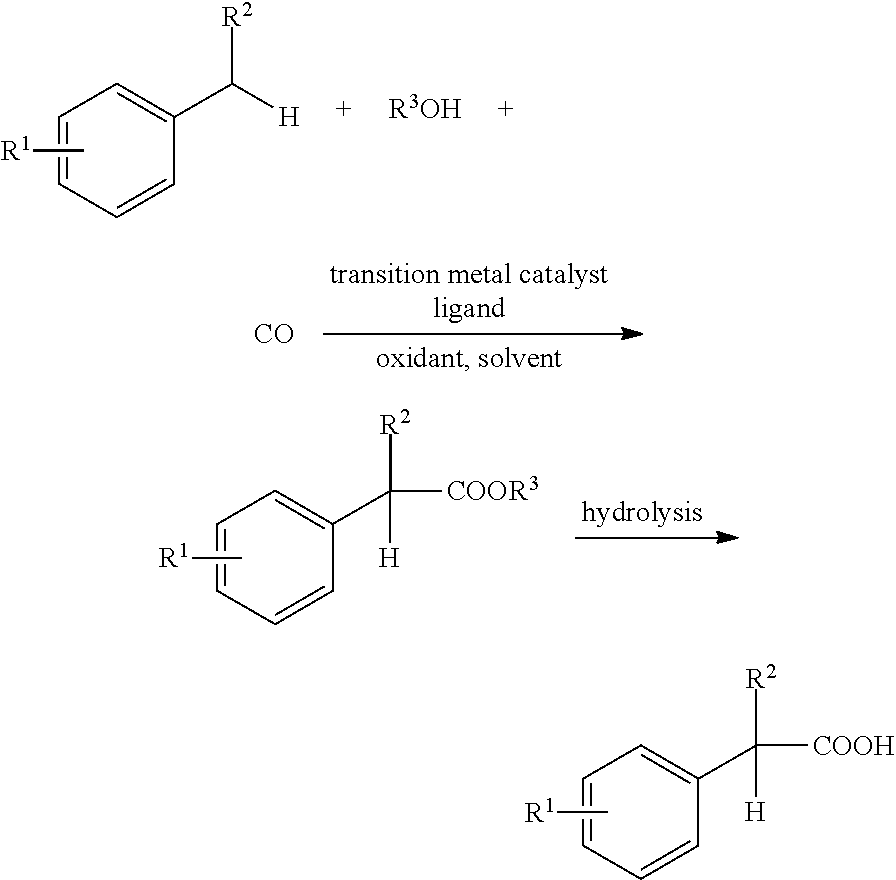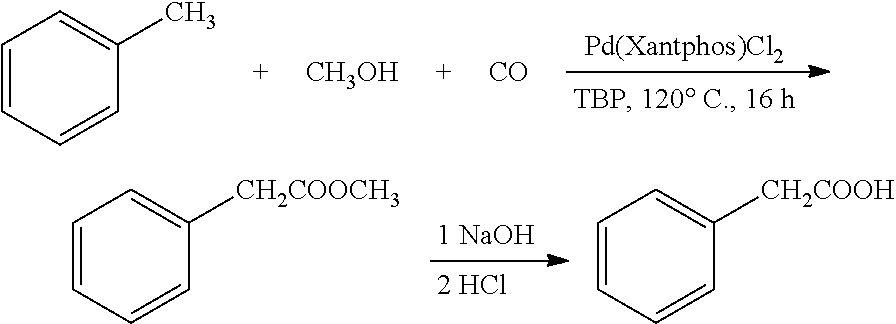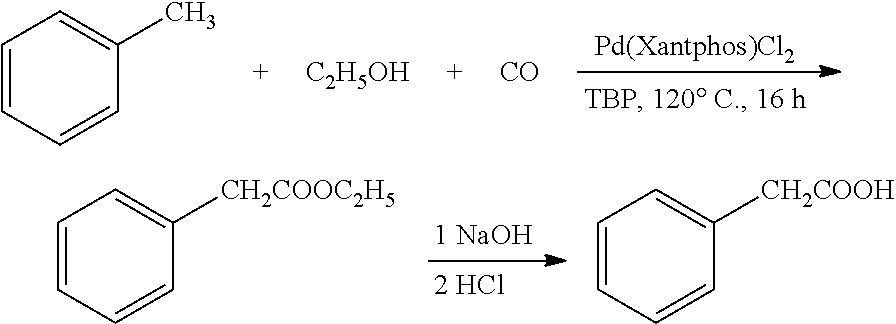Process for synthesizing phenylacetic acid by carbonylation of toluene
a technology of phenylacetic acid and carbonylation, which is applied in the direction of carbon monoxide or formate reaction, preparation from carboxylic acid esters/lactones, organic chemistry, etc., can solve the problem of relatively insufficient toluene production, and achieve high yield and high yield
- Summary
- Abstract
- Description
- Claims
- Application Information
AI Technical Summary
Benefits of technology
Problems solved by technology
Method used
Image
Examples
example 1
Preparation of Phenylacetic Acid from Toluene and Methanol
[0030]
[0031]Toluene (1.38 g), methanol (32 mg), di-tert-butyl peroxide (73 mg, 1 equivalent), and Pd(Xantphos)Cl2 (3.8 mg, 1 mol %) were added into a reaction kettle, into which 10 atm carbon monoxide was introduced. The reaction was heated to 120° C., and stirred at this constant temperature for 16 h. After the reaction was completed, carbon monoxide was discharged, and 67 mg methyl phenylacetate was obtained by column chromatography, in a yield of 89%. 1HNMR (400 MHz, CDCl3) δ 3.60 (s, 2H), 3.65 (s, 3H), 7.22-7.32 (m, 5H); 13CNMR (100 MHz, CDCl3) δ 41.2, 52.0, 127.1, 128.6, 129.3, 134.1, 172.0; HRMS (ESI) calcd. for C9H10NaO2 [M+Na]: 173.0568. found: 173.0573. The methyl phenylacetate obtained was dissolved in 1,4-dioxane. 6 N sodium hydroxide solution was added, and the reaction was heated to 60° C. After 2 h of reaction, the pH value was adjusted to 1 by adding 2 N hydrochloric acid. After removing the organic solvent und...
example 2
Preparation of Phenylacetic Acid from Toluene and Ethanol
[0032]
[0033]Toluene (1.38 g), ethanol (46 mg), di-tert-butyl peroxide (73 mg, 1 equivalent), and Pd(Xantphos)Cl2 (3.8 mg, 1 mol %) were added into a reaction kettle, into which 10 atm carbon monoxide was introduced. The reaction was heated to 120° C., and stirred at this constant temperature for 16 h. After the reaction was completed, carbon monoxide was discharged, and 76 mg ethyl phenylacetate was obtained by column chromatography, in a yield of 93%. 1HNMR (400 MHz, CDCl3) δ 1.23 (t, J=7.2 Hz, 3H), 3.61 (s, 2H), 4.12 (q, J=7.2 Hz, 2H), 7.24-7.35 (m, 5H); 13CNMR (100 MHz, CDCl3) δ 14.2, 41.5, 60.9, 127.0, 128.6, 129.3, 134.2, 171.6; HRMS (ESI) calcd. for C10H12NaO2 [M+Na]: 187.0728. found: 187.0730. The ethyl phenylacetate obtained was dissolved in 1,4-dioxane. 6 N sodium hydroxide solution was added, and the reaction was heated to 60° C. After 2 h of reaction, the pH value was adjusted to 1 by adding 2 N hydrochloric acid. A...
example 3
Preparation of Phenylacetic Acid from Toluene and n-Propanol
[0034]
[0035]Toluene (1.38 g), n-propanol (60 mg), di-tert-butyl peroxide (73 mg, 1 equivalent), and Pd(Xantphos)Cl2 (3.8 mg, 1 mol %) were added into a reaction kettle, into which 10 atm carbon monoxide was introduced. The reaction was heated to 120° C., and stirred at this constant temperature for 16 h. After the reaction was completed, carbon monoxide was discharged, and 78 mg n-propyl phenylacetate was obtained by column chromatography, in a yield of 88%. 1HNMR (400 MHz, CDCl3) δ 0.88 (t, J=7.6 Hz, 3H), 1.59-1.67 (m, 2H), 3.61 (s, 2H), 4.12 (t, J=6.8 Hz, 2H), 7.23-7.33 (m, 5H); 13CNMR (100 MHz, CDCl3) δ 10.3, 21.9, 41.5, 66.4, 127.0, 129.3, 134.3, 171.7; HRMS (ESI) calcd. for C11H14NaO2 [M+Na]: 201.0886. found: 201.0886. The n-propyl phenylacetate obtained was dissolved in 1,4-dioxane. 6 N sodium hydroxide solution was added, and the reaction was heated to 60° C. After 2 h of reaction, the pH value was adjusted to 1 by a...
PUM
| Property | Measurement | Unit |
|---|---|---|
| temperature | aaaaa | aaaaa |
| temperature | aaaaa | aaaaa |
| temperature | aaaaa | aaaaa |
Abstract
Description
Claims
Application Information
 Login to View More
Login to View More - R&D
- Intellectual Property
- Life Sciences
- Materials
- Tech Scout
- Unparalleled Data Quality
- Higher Quality Content
- 60% Fewer Hallucinations
Browse by: Latest US Patents, China's latest patents, Technical Efficacy Thesaurus, Application Domain, Technology Topic, Popular Technical Reports.
© 2025 PatSnap. All rights reserved.Legal|Privacy policy|Modern Slavery Act Transparency Statement|Sitemap|About US| Contact US: help@patsnap.com



